
Like many of the coolest new technologies, sometimes the idea of a new product or concept is better than the actual thing. I’m finding out first hand that such is the case with many smart home and smart appliance products.
Thanks to the recent demise of our oven, a non-functioning ice maker in the fridge, and a burnt-out lamp on our cooktop, my wife and I recently decided it was to time to take the plunge and invest in a new set of kitchen appliances. Like many American couples, we started our search at the local big box store, investigated a specialty retailer or two, did a bunch of research online, and finally settled on a nice matching set of new GE appliances.
While the end result isn’t very interesting, going through the process of making the decision and realizing what some of the real world issues and questions that arise during that process are, was interesting. Oh, and not particularly positive for the near term future of smart homes.
GE’s new smart appliances all have apps you can run on iPhones or Android phones, but who’s to say that even in ten years (let alone 15 or 20) we’ll be carrying a device that can still run those apps?
First, of course, there was the question of color and style. Kitchen appliances, in particular, are something you see and interact with every day and, frankly, one of the key factors in our decision was actually the color and finish (slate grey) of the appliances. Once that was determined, we started looking at the choices within that range. Now admittedly, not everyone uses color as a primary factor, but it really hit me during this process that color is more important than it would ever be for standalone tech products.
The color also impacted the range of functionality (and degree of smarts) that were going to be available to us. For example, GE has begun producing a line of smart appliances, including a smart oven in the same basic model range as the oven we had selected. Unfortunately, it turns out the smart oven is only available in black or stainless steel—not slate grey. Again, some people may have chosen to get the smart functionality but, given the importance of the aesthetic design—and the even more important WAF (Wife Acceptance Factor)—the smart oven fell off the range of options.
Timing and functionality are also issues. The new GE connected refrigerator won’t be available until later this spring but we needed to replace our fridge now. Plus, frankly, all the smart fridge seems to offer is a warning the water filter needs to be replaced and an optional alarm when someone leaves the door open. Nice to have, sure, but really essential? Hardly. Same thing with the new smart dishwasher. Getting an alert the dishes are done isn’t my idea of something I need to have.
In the case of the smart oven, the ability to remotely start preheating your oven, get a timer notice when something has finished cooking, or change the temperature or turn off the oven from the comfort of your sofa, did actually sound modestly interesting. But then the paranoid side of me kicked in and I realized that, though highly unlikely, a device sitting on my home WiFi network could theoretically get hacked (despite both mine and GE’s best efforts.) Now, if there was one appliance in my home I really didn’t want to be taken over and remotely controlled by someone other than my family, it would be the oven because, in theory, it could actually end up burning your house down. So, my previous disappointment with not getting at least one smart appliance in the overhaul actually morphed into a modest sense of relief.
Another thing that really hit me during this process is timing. The appliances we’re replacing probably had an average age of 20 years and I’m counting on getting roughly another 20 years from the new ones. That’s literally a 10x longer lifespan than we typically think about for most tech products. Conversations I’ve had with many companies working in the smart home space acknowledge this decades-long home product lifetime dilemma, but don’t really know how to address questions related to it. GE’s new smart appliances all have apps you can run on iPhones or Android phones, but who’s to say that even in ten years (let alone 15 or 20) we’ll be carrying a device that can still run those apps?
It reminds me of the in-wall radio and intercom system our house was built with nearly 40 years ago. At the time, I’m sure it was considered fairly cutting edge, but they likely fell out of use within five years of their installation and we now see them as almost an historical oddity. Many of today’s smart home products seem destined to suffer that same fate. In fact, I’m concerned those fears will keep the reality of the smart home market at a significantly lower level than what the concept of a smart home might otherwise suggest.
Bob O’Donnell is the founder and chief analyst of TECHnalysis Research, LLC a technology consulting and market research firm that provides strategic consulting and market research services to the technology industry and professional financial community. You can follow him on Twitter @bobodtech. This article was originally published on Tech.pinions.
https://www.techspot.com/news/60076-smart-appliances-dilemma.html